.png?width=250&height=250&name=Email%205.23%20Rossi%E2%80%99s%20Roundup%20(1).png) In case you didn’t notice, RKD has made a commitment to #QuitBadFundraising. It’s a process and will take time, but we are dedicated! To find out more, visit QuitBadFundraising.com. Better yet, if you want to state your own thoughts and see what others are doing, then jump on LinkedIn and use the hashtag #QuitBadFundraising.
In case you didn’t notice, RKD has made a commitment to #QuitBadFundraising. It’s a process and will take time, but we are dedicated! To find out more, visit QuitBadFundraising.com. Better yet, if you want to state your own thoughts and see what others are doing, then jump on LinkedIn and use the hashtag #QuitBadFundraising.
When the weather heats up, that means it’s the time of year to consider improving data hygiene, tightening your stewardship plans, and interacting with your major donors more often between visits. And don’t forget to brainstorm how you’re going to make your donors feel like they are on the front lines with you more often.
Remember, donors give because they have a passion to solve a problem, to heal a hurt, to make things right. They are searching for ways to be intimately involved in the restoration of a human life, an animal’s predicament, a wetland, etc.
They believe by giving to your organization that you’ll follow through and make a change in something that matters to them. But are you following through? And does your donor know that their giving made a difference? Have you shared specific information on what their giving is doing to change XYZ?
Start thinking of all the ways you can show gratitude and let your donors know their giving has made a difference. Then, do it aggressively and with purpose.
Grab your favorite beverage, take a break and dive into a few of the many articles I’ve been reading over the past month (caution: graphs ahead).
“The thing you need, the road ahead, the element that will transform your [fundraising]—it appears to be inconvenient. That’s terrific because it means that most other people can’t be bothered. It’s valuable because the very inconvenience of it makes it scarce. The stuff that matters is almost always inconvenient. If it’s not, you might be mistaken about what matters.” — Seth Godin
1. Reminder: Update your organization’s ratings
 It’s time to update your organization’s Candid/GuideStar and Charity Navigator. While you’re at it:
It’s time to update your organization’s Candid/GuideStar and Charity Navigator. While you’re at it:
- Check to see if your organization is listed on CharityWatch Top-Rated Charities list.
- Check the BBB Give.org to see if your organization is on the list.
2. Giving USA The Annual Report unveiling
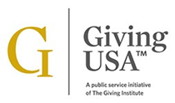 The week of June 20 unveiled the key critical findings from Giving USA The Annual Report on Philanthropy.
The week of June 20 unveiled the key critical findings from Giving USA The Annual Report on Philanthropy.
I’m sure you’ve already seen the headline, “U.S. Philanthropy Plummeted $17 Billion as Donors Disappeared” or “Overall Philanthropic Giving Revenue Fell 3.4% in 2022” or something similar.
Individual giving, however, fell 6.4% — or 13.4% when adjusting for inflation. Although donor-advised fund giving held steady, new investments in some major DAFs dropped by 29%, indicating donor uncertainty. High inflation affected all nonprofits, leading to a loss of purchasing power, shifting priorities and unstable funding.
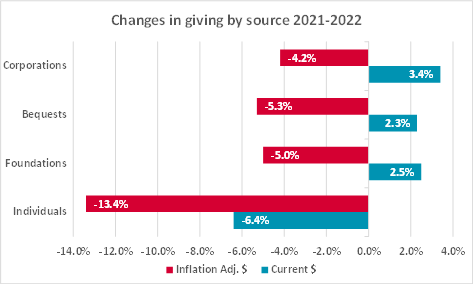
Nevertheless, giving to five of the nine subsectors was higher in 2022 than it was in 2020, even when adjusted for inflation. There was a 20 to 25% decline in the stock market and an 8% inflation rate, but Americans still gave nearly a half trillion dollars. Adjusted for inflation, disposable personal income declined by 7.5 percent.
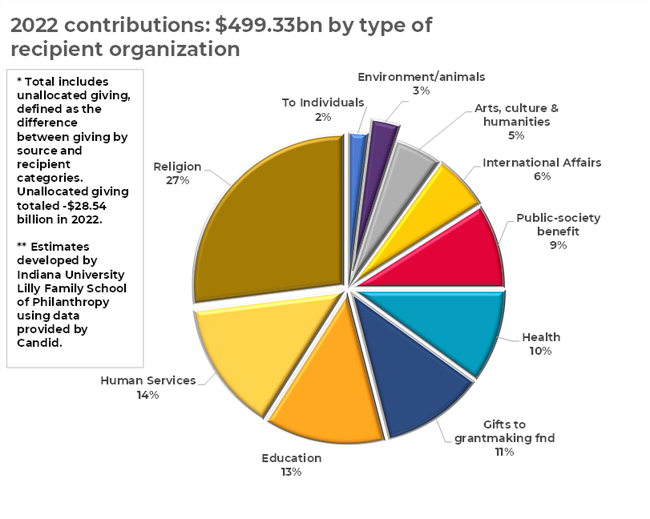
It’s important as we all navigate the changing face of fundraising that we are prioritizing donor relationships, auditing, building and monitoring our tech stacks by leveraging technology and reimagining our strategies.
"Not enough people are being moved to contribute – because our practices perpetuate talking at them, not talking with them or listening to them. As a sector, we have to change. We must work harder than ever to innovate and deepen relationships with donors, no matter how much they give,” said Chris Pritcher, CEO, RKD Group, The NonProfit Times.
Full report will be released July 11.
3. There’s a $75 trillion reason the economy won’t crash into a recession, top economist says: Baby boomers’ pent-up net worth
 Things to keep in mind as you reach out to your donors and deepen/strengthen relationships: a variety of planned giving vehicles have become more mainstream so make sure you’re providing those options to your donors.
Things to keep in mind as you reach out to your donors and deepen/strengthen relationships: a variety of planned giving vehicles have become more mainstream so make sure you’re providing those options to your donors.
This article in Fortune paints a clear picture of the wealth that baby boomers have accumulated.
“Baby boomers, defined as those born between 1946 and 1964, had a net worth of $74.8 trillion at the end of the first quarter. Nearly $19 trillion of that wealth was held in real estate, including equity in personal homes. But economist Dr. Ed Yardeni, President of Yardeni Research, said that boomers have 'the bulk' of their excess savings 'parked in liquid assets,' including $8.9 trillion in bank deposits and money market funds alone, which should enable them to keep spending even in a slowing economy.
“It’s not just baby boomers who have cash stacked away either. The silent generation, which the Fed defines as those born before 1946, boasted a net worth of nearly $18 trillion in the first quarter. And Americans’ overall net worth has increased 34% over the past three years alone, from $104.2 trillion in the first quarter of 2020 to $140.6 trillion in the first quarter of this year.”
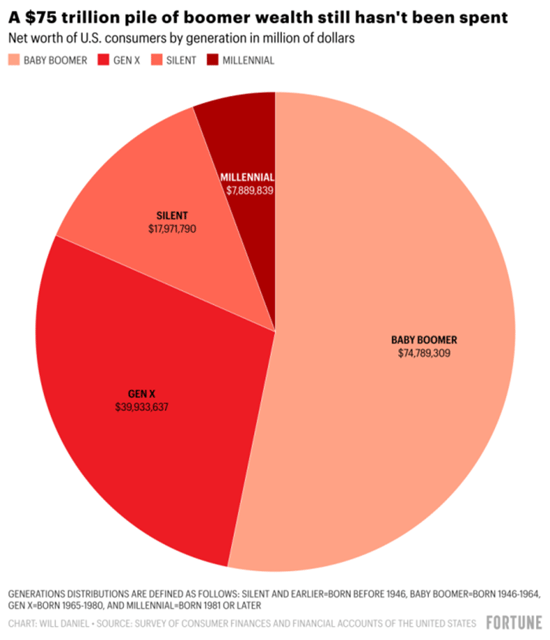
4. Op-ed: Why I stopped donating to your organization
 Just … wow. This is why we must be better at listening to our donors!!!
Just … wow. This is why we must be better at listening to our donors!!!
You’ll want to click through and read this article in depth, if you have paid access. For those who don't, I’ve extracted the following sentences/paragraphs:
- “I am a baby boomer in my mid-70s … I have given initial donations of $1,000 to $5,000 to see how the organizations respond. I expect them to promptly acknowledge my gift, then explain how it’s being used.”
- “… I expected some information about the award and how the organization would use it. I wanted to know if I should redirect or reduce my contribution to ensure it did the most good or went where the need was greater, but nothing materialized. I contacted the director but never heard back.”
- “… I asked another organization for additional clarity about where money from my estate might eventually go and included a donation for immediate use. I am still waiting for that requested information.”
- “… I asked for more information about counties served and the type of aid provided. No response.”
- “Collectively, these nonprofits have lost about $20,000 in annual gifts and $100,000 in estate allocations from me because of their inadequate responses.”
- “Most of the donation receipts I get take at least a month to arrive, and some take more than two months.”
- “Along with a donation to an organization addressing hunger, I included a handwritten note saying I wanted to visit its office. I didn’t hear back for a month until I needed to ask for a receipt for tax purposes. I received the receipt but nothing about my request.”
- “Transparency matters. If organizations want to maintain relationships with their donors and encourage further gifts, they need to listen, ask questions, and respond to donors’ needs. Only then can they effectively work together for the greater good.”
5. The key to more revenue? Moving out of a transactional fundraising mindset
 When you’re in a transactional fundraising mindset, your actions are ultimately in service of getting the money—not developing relationships. It’s impersonal, and donors are not engaged in meaningful ways with their heads and their hearts.
When you’re in a transactional fundraising mindset, your actions are ultimately in service of getting the money—not developing relationships. It’s impersonal, and donors are not engaged in meaningful ways with their heads and their hearts.
Staying in a transactional mindset not only impacts how much donors give or their engagement over time, but it also impacts the fundraiser. You may experience feelings of frustration, guilt, anger and emptiness as you are pressured to bring in the money without any investment in authentic relationships. Donors feel used, unengaged and either give less or go away. It is simply a transaction.
You shouldn’t treat your donors like ATMs.
6. Wealthier should give to charity, say people who stopped donating, new poll finds
 A new poll of Americans found that nearly half of those who stopped giving to charity over the past five years said they did so because they thought wealthier people could afford to give more—and should. Others said they simply could not afford to give.
A new poll of Americans found that nearly half of those who stopped giving to charity over the past five years said they did so because they thought wealthier people could afford to give more—and should. Others said they simply could not afford to give.
The survey also found:
- Older generations were more likely to have donated over the past five years, with 72 percent of respondents aged 76 and above maintaining or increasing their contributions, compared with 67 percent of boomers, 57 percent of Gen Xers, 57 percent of millennials and 42 percent of Gen Zers.
- Respondents who stopped contributing to charities were less likely than those who maintained their contributions to believe that donating to nonprofits was more effective than shopping at socially responsible businesses, with only 1 in 4 saying that donating had a stronger impact. Among Gen Zers, 52 percent said that shopping at responsible businesses had the same or greater impact.
- Participants who stopped donating to charities over the past five years said they were most likely to increase future contributions if it was easier to find charities serving their community (17.6 percent) or led by people who share their political identity (17.6 percent).
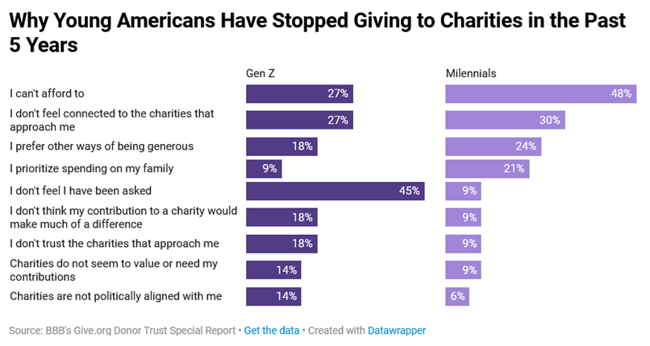
“If we can grow giving that’s rooted in people’s holistic sense of who they are, it’s going to be more sustainable because it’s rooted in their experience,” says Jen Shang, co-director of the Institute for Sustainable Philanthropy and an expert in philanthropic psychology, who noted that identity-based giving can be more reliable than donations driven by bursts of generosity, for example, in the aftermath of a natural disaster.
7. America Is getting older
 The nation’s median age increased by 0.2 years to 38.9 years between 2021 and 2022, according to Vintage 2022 Population Estimates released today by the U.S. Census Bureau. Median age is the age at which half of the population is older and half of the population is younger.
The nation’s median age increased by 0.2 years to 38.9 years between 2021 and 2022, according to Vintage 2022 Population Estimates released today by the U.S. Census Bureau. Median age is the age at which half of the population is older and half of the population is younger.
A third (17) of the states in the country had a median age above 40.0 in 2022, led by Maine, with the highest at 44.8, and New Hampshire at 43.3. Utah (31.9), the District of Columbia (34.8) and Texas (35.5) had the lowest median ages in the nation. Hawaii had the largest increase in median age among states, up 0.4 years to 40.7.
No states experienced a decrease in median age. Four states — Alabama (39.4), Maine (44.8), Tennessee (39.1), West Virginia (42.8)—and the District of Columbia (34.8) had no change in their median age from 2021 to 2022.
8. Four ways to tap into DAF dollars
 From FreeWill’s The nonprofit’s guide to donor-advised funds:
From FreeWill’s The nonprofit’s guide to donor-advised funds:
- DAFs are skyrocketing in number and in the amount of money in them. There was $234 billion in DAFs at the end of 2021—up 40% over 2020.
- They’re giving out more. DAFs granted $46 billion in 2021, 28% more than in 2020.
- A lot more of that money went to those who actively sought it: Organizations that specifically solicited DAFs received 2.2 times more DAF dollars in 2022 than those that didn’t.
- Actively promote donor-advised funds on your donation page. Add a link that says something like, “Give from my Donor-Advised Fund.” The link should then take them to a page that guides them through the DAF grant process.
- Ask major donors and prospects if they have a DAF. Just ask. It’s increasingly likely that major donors do have one.
- Make sure your Guidestar profile is up to date. Many DAF sponsoring organizations rely on Guidestar to make sure nonprofits are in good standing and to make sure grants go to the right place.
Get to know the leaders of your local community foundations. While most DAFs are run by large financial firms, a significant number are connected to community foundations (20% of total grant dollars in 2021). Community foundations are much more active than financial firms in recommending organizations for grants.
9. Why wealthy donors are distancing themselves from nonprofits
 Something has quietly been happening at the millionaire and billionaire levels right under everyone’s noses, writes Paul D’Alessandro. It's a shift away from dealing directly with nonprofit executives and fundraisers, and instead, wealthy donors are adding layers of distance between themselves and the nonprofits they support.
Something has quietly been happening at the millionaire and billionaire levels right under everyone’s noses, writes Paul D’Alessandro. It's a shift away from dealing directly with nonprofit executives and fundraisers, and instead, wealthy donors are adding layers of distance between themselves and the nonprofits they support.
Many wealthy individuals and families now prefer working through intermediaries, such as lawyers, donor-advised funds (DAFs) and donor advisories to handle their giving activities. It's a pattern that's developed over some time, and it’s becoming much more commonplace.
As a result of all of this, nonprofit organizations face a growing challenge. They must adapt to a world that will create even more distance. Here are a few tips to help make the adjustment:
- Leverage Technology
- Strengthen Reporting and Transparency
- Develop a Broad Donor Base
- Engage with Donor Advisories
As we all know, philanthropy is evolving, and nonprofits must adapt accordingly.
10. Check out more great posts, podcasts and webinars
Blog updates:
- Inclusive outreach: Build a multicultural marketing framework for donors
- Inclusive outreach: Examples of successful marketing to diverse communities
- From analytics to AI to anti-competitive accusations, Google takes the spotlight
- It’s time to rethink event donor conversion
- 9 risks to nonprofit fundraising in the second half of 2023
Podcast updates:
- Matt Monberg thinks about being fearless and taking risks
- Ruth Rathblott thinks about ‘unhiding’ and building inclusive connections
- For even more go to: https://rkdgroup.com/podcast/
Past Webinar Recordings:
- Transform your newsletters to be donor-centric with Lisa Rossi
- Craft captivating videos that engage your donors with Chris Weiland
- How to build stories around your content with Billy Vaudry
- Develop inclusive and effective messaging with Erin Albitz
- For even more go to: https://info.rkdgroup.com/webinars






Leave a comment: